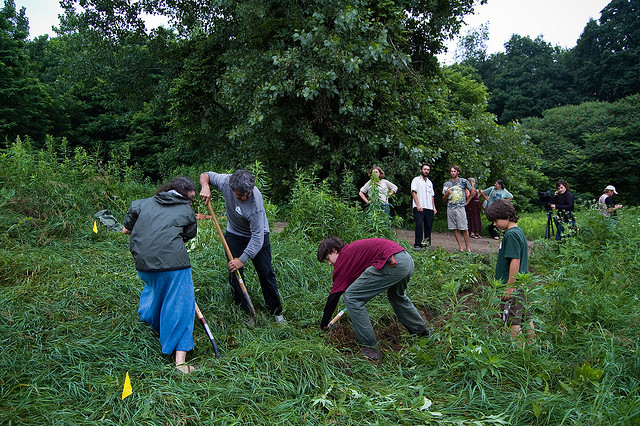Permaculture For Sustainability
A few years ago, while working with local organic farmers and promoting a local food initiative, I came across this beautiful film about permaculture, the oil crisis, and how to heal the land after years of conventional farming.
Many of the farms in my own community were already exploring ways to become more sustainable in their practices. This ranged from following Joel Salatin’s philosophy of farming (field rotation, grass fed livestock, etc.) to working with local land conservancies for reforestation of fallow fields.
The area I live in is primarily farmed for dairy as well as several CSA’s (Community Shared Agriculture) schemes in vegetable, honey, maple syrup and berry production. I, as well as many others, concerned about animal welfare, preservation of topsoil, and keeping farming families on the land (and staving development) held many farm table talks about the best ways to accomplish our goals.
We were a motley crew, some of us meat eaters, some of us vegetarians, some of us vegans and all of us striving for a healthier planet. Believe me, finding middle ground within such a framework of beliefs is not easy. But safe to say, we all wanted what was best for the community of humans and animals.
We came to understand that between us, we would all contribute from our unique perspectives what was best for this initiative. Permaculture principles came to the forefront. Our finger on the pulse of the oil crisis was just as important.
The documentary you are about to watch is filmed in the UK, by wildlife videographer Rebecca Hosking who is returning to the family farm. She talks about the importance of bringing wildlife back to the farm eco-system and re-introducing hedgerows as wildlife corridors, as well as moving away from mono-culture in an attempt to revive the soil.
What is permaculture? How does it mimic nature?
Central to permaculture are the three ethics: care for the earth, care for people, and fair share. They form the foundation for permaculture design and are also found in most traditional societies. Here are the 12 principles of permaculture as described by David Holmgren:
1. Observe and Interact: “Beauty is in the mind of the beholder.”
By taking the time to engage with nature we can design solutions that suit our particular situation.
2. Catch and Store Energy: “Make hay while the sun shines.”
By developing systems that collect resources when they are abundant, we can use them in times of need.
3. Obtain a yield: “You can’t work on an empty stomach.”
Ensure that you are getting truly useful rewards as part of the work you are doing.
4. Apply Self-Regulation and Accept Feedback: “The sins of the fathers are visited on the children of the seventh generation.”
We need to discourage inappropriate activity to ensure that systems can continue to function well. Negative feedback is often slow to emerge.
5. Use and Value Renewable Resources and Services: “Let nature take its course.”
Make the best use of nature’s abundance to reduce our consumptive behavior and dependence on non-renewable resources.
6. Produce No Waste: “Waste not, want not” or, “A stitch in time saves nine.”
By valuing and making use of all the resources that are available to us, nothing goes to waste.
7. Design From Patterns to Details: “Can’t see the forest for the trees.”
By stepping back, we can observe patterns in nature and society. These can form the back bone of our designs, with the details filled in as we go.
8. Integrate Rather Than Segregate: “Many hands make light work”
By putting the right things in the right place, relationships develop between those things and they work together to support each other.
9. Use Small and Slow Solutions: “Slow and steady wins the race” or, “The bigger they are, the harder they fall.”
Small and slow systems are easier to maintain than big ones, making better use of local resources and produce more sustainable outcomes.
10. Use and Value Diversity: “Don’t put all your eggs in one basket.”
Diversity reduces vulnerability to a variety of threats and takes advantage of the unique nature of the environment in which it resides.
11. Use Edges and Value the Marginal: “Don’t think you are on the right track just because it’s a well-beaten path.”
The interface between things is where the most interesting events take place. These are often the most valuable, diverse and productive elements in the system.
12. Creatively Use and Respond to Change: “Vision is not seeing things as they are but as they will be.”
We can have a positive impact on inevitable change by carefully observing and then intervening at the right time.
I’m still learning about this and applying what I learn to my own small homestead. It is a system that requires dedication to working with nature, not against it.
While the farm in this documentary is one that raises livestock, permaculture design works well with farms that grow primarily veggies and fruit as well.
This film confirms the need for caring for our soil, our animals and our planet as an urgent matter. As much as we need to cut our consumption of meat, it is plain that not everyone can or will be a vegetarian/vegan. As such, we must find ways to fit sustainability measures into mixed farming, and to create solutions to the top soil erosion due to cultivation of wheat, corn and soy. I feel that permaculture is one way to achieve that goal. Please enjoy.
Relephant Read:
The Embarrassingly Simple Solution to Climate Change.
Author: Monika Carless
Editor: Travis May
Photo: Flickr/Brian Boucheron







Read 1 comment and reply